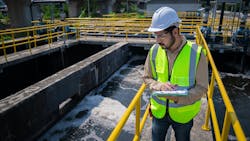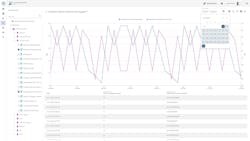Unlocking your plant's potential with data-driven excellence
In an industry where tribal knowledge has long been the cornerstone of operational success, wastewater treatment plants stand at a crossroads. While experienced operators have traditionally relied on instinct and accumulated wisdom to make crucial decisions, the mounting pressures of staff shortages, growing service populations, and stricter regulatory requirements demand a more systematic approach to plant management. The most valuable resource in overcoming these challenges might be hiding in plain sight: your data.
The hidden value in your plant's data
Every wastewater treatment facility generates thousands of data points daily, from flow readings and chemical dosages to laboratory results and equipment performance metrics. Hidden within this sea of information lies the potential to optimize operations, reduce costs, ensure compliance, and extend asset lifespans.
The challenge isn't gathering more data, it's transforming the data utilities already have into actionable intelligence.
When a seasoned operator with decades of experience retires, they take with them invaluable knowledge about how the plant responds to specific conditions, which pump tends to struggle during heavy rainfall, how chemical dosing should be adjusted during temperature fluctuations, or which processes need special attention during seasonal changes. Without a systematic way to capture and transmit this knowledge, plants are at risk for operational inefficiencies, compliance violations, and significantly higher costs.
Breaking down data silos
Modern data management software, like Hach WIMS (Water Information Management System) helps wastewater treatment plants break down data silos and transform scattered information into operational intelligence. It starts with a centralized platform where data from multiple sources, such as SCADA systems, laboratory results, and field observations, converges into a unified, accessible resource.
Today’s treatment plants require more than just readings. They need intelligent integration of information across all five layers of plant operations:
- Physical Infrastructure: The foundation of any plant — pumps, tanks, pipes, and treatment units — must be properly maintained and monitored.
- Sensors and Controls: Strategic deployment of reliable instrumentation to track critical parameters and enable responsive process control.
- Data Collection and Communication: Secure systems that gather readings from SCADA, field observations, laboratory analyses, and other sources.
- Data Management and Display: Centralized platforms that organize information and make it accessible through intuitive dashboards and reports.
- Data Fusion and Analytics: Advanced tools that transform raw numbers into actionable intelligence through alerts, trends, predictive models, and automated responses.
Each layer builds upon the previous one, creating a powerful ecosystem where data flows seamlessly from collection to analysis to action. The result is better compliance and potential for significant operational optimization.
A trend tells a story
Data tells stories that even the most attentive operator might miss. Consider a chemical discharge pump that has been on its lowest setting for months. To the operator who sees it daily, this condition becomes normalized as just another quirk of the system. But when plotted on a trend line alongside flow data and effluent quality, the oversized pump reveals itself as a critical point causing chemical overdosing, wasted resources, and potential compliance risks.
These data-driven narratives provide compelling evidence for capital improvements, process adjustments, or maintenance interventions. Instead of relying on anecdotal observations, operators can present decision-makers with clear, objective evidence of operational challenges and potential solutions. This transforms the conversation from "I think we need a new pump" to "Here's the data showing how this oversized pump is costing us $30,000 annually in wasted chemicals."
Resilience in a changing environment
From hurricanes in the Carolinas to blizzards in the Midwest and droughts in the West, treatment plants must adapt to increasingly volatile environmental conditions. Modern data management systems provide the situational awareness needed to respond effectively to these challenges.
By aggregating historical performance data, current operating conditions, and even weather forecasts, these systems can help operators anticipate problems before they occur. Automated alerts can notify staff of potential issues, while prescriptive analytics can recommend specific adjustments to maintain treatment objectives during extreme events. This proactive approach keeps plants operating efficiently and in compliance, even when operators cannot be physically present due to hazardous conditions.
Data defensibility and security: Non-negotiable requirements
Every time information is manually transferred, from a sticky note to a bench sheet, from a clipboard to a computer, opportunities for errors multiply. Modern data management platforms eliminate these risks through direct digital capture, automated validation checks, and secure storage with comprehensive audit trails.
This level of data defensibility is not just about avoiding transcription errors. It is about creating an unimpeachable record of operational decisions and compliance activities that can withstand regulatory scrutiny. When questions arise about a particular discharge event or treatment process, operators can retrieve the complete historical context, demonstrating exactly what happened and why specific actions were taken.
Equally important is cybersecurity. As critical infrastructure providers, wastewater utilities must implement robust protections against unauthorized access and potential attacks. Any data management solution must include state-of-the-art security features, regular vulnerability assessments, and clear protocols for responding to potential breaches.
A good data management system needs to have:
- Chain of Custody: Complete audit trails tracking every data point from source to report
- Validation Rules: Automatic flagging of anomalous readings for verification
- Quality Assurance: Built-in protocols to verify instrument calibration and sampling procedures
- Secure Access Controls: Role-based permissions ensure that only authorized personnel can view or modify data
Preserving and leveraging institutional knowledge
Every wastewater plant benefits from operators with deep institutional knowledge - professionals who instinctively know how the facility responds to changing conditions. However, this tribal knowledge represents a significant organizational risk when it exists only in the minds of veteran staff.
System and data management programs, such as WIMS, create a permanent, accessible repository of operational history, capturing the what, when, why, and how of plant operations. This institutional memory becomes an invaluable training resource for new operators, allowing them to benefit from decades of experience even when their mentors are no longer available for direct consultation. By studying historical data alongside annotated explanations, newcomers can develop a deeper understanding of plant dynamics and accelerate their development into skilled operators.
The path forward: From data collection to intelligent operations
Implementing a good digital data management solution is more than just a software upgrade. It can be an operational transformation. It begins with good data from reliable instruments, expands through centralized data management, and culminates in a self-responsive facility where operators can make informed decisions.
With an aging workforce, tight budgets, and evolving regulatory compliance, wastewater facilities can no longer afford the inefficiency of paper or the loss of veteran knowledge. The solution lies in harnessing modern data management software, not to replace human expertise, but to enhance, preserve, and securely share information with all stakeholders.
Modern data management solutions provide the critical infrastructure to ensure that once you do something, you do it well and you do it right, and it is safe and secure for all of time.
About the Author

Dave Rutowski
Dave Rutowski has been in the water industry for over 20 years, starting as a wastewater lab chemist, later becoming a process optimization specialist for Hach, and most recently joined Aquatic Informatics as senior manager of global sales enablement helping software sellers integrate into a process-focused industry.


